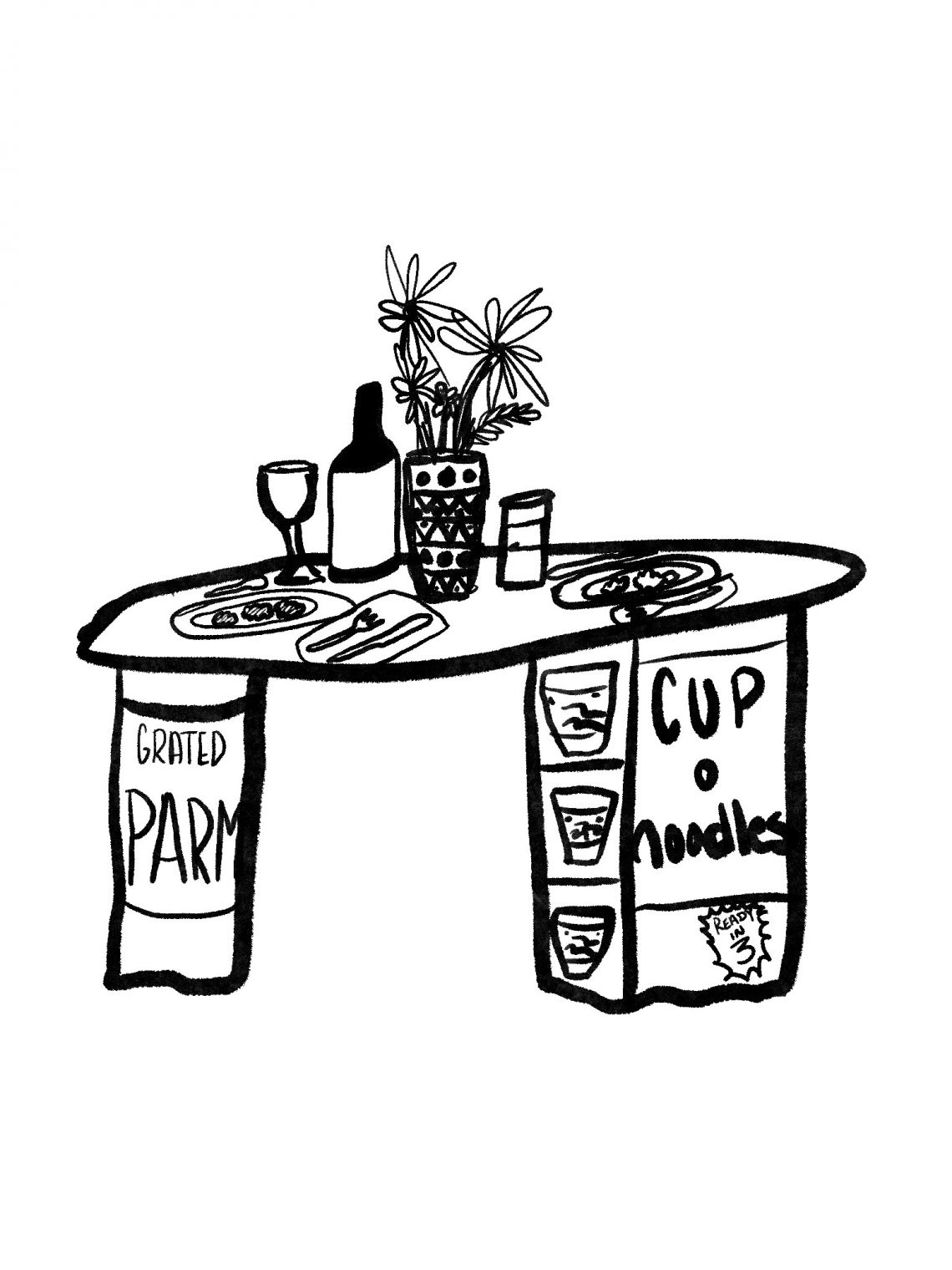Why I’m No Longer Embarrassed About Taking Shortcuts in the Kitchen
by Ruth Kogen Goodwin
Ruth’s essay appears in episode 28 of The Dirty Spoon Radio Hour.
Tonight, I made a hearty, comforting chicken soup. I mixed pre-cut vegetables, boxed chicken broth, dried ground seasonings, packaged pasta, and deboned chicken pieces in my Instant Pot, sealed the lid, and pressed start. Along with an easy-to-assemble bagged salad mix and some rolls, I fed my family dinner.
Recently, a viral Tweet disparaged these sorts of pre-prepared “convenience” ingredients—specifically bottled lemon juice, generic table salt, Kraft parmesan cheese, and jarred minced garlic. Apparently, these are the hallmarks of a poor cook. Thousands of people liked the tweet, including popular Twitter personality, cookbook author, and cookware purveyor Chrissy Teigen, who felt it wise to retweet her agreement to her millions of followers.
Though I do not typically care what people on Twitter think of my cooking skills, I’ll admit that when I saw the post and retweet, my heart dropped. I have long used these types of convenience ingredients when I cook due to a disability that makes it difficult to stand for extended periods of time. Such products allow me to save prep time so I can assemble full recipes.
I used to be embarrassed by the shortcuts I had to take. However, the robust counter-response to the viral tweet showed me that I am far from the only one to rely on convenient ingredients, and it is nothing to be ashamed of.
I am far from the only one to rely on convenient ingredients, and it is nothing to be ashamed of.
Convenience food, defined as food that is processed so it can be prepared quickly for easy consumption, is not new. In fact, it’s as old as, well, food itself. Nearly two million years ago, when humans first butchered animals and cooked meat over an open flame, they created sustenance that was better preserved and easier to digest than raw meat. This could arguably be seen as a step towards convenience food. There is also evidence that prior to the advent of agriculture around 12,000 years ago, early Europeans were already baking bread using the starches from the roots of cattails and ferns. As early as 30,000 years ago, humans pounded these roots into flour, mixed this powder with water, and baked it into loaves of bread. These loaves were portable, nutrient-dense, and resistant to spoilage, all of which are the desirable characteristics of many convenience foods today.
When industrial technology entered the picture in the early 19th century, convenience food, first in the form of meat packing and later as canned goods, became more popular than ever. One of the earliest manufacturers still in operation, Van Camp, supplied canned beans to the Union Army in the 1860s. Returning veterans brought back a taste for and an appreciation of the convenience of canned foods.
Post-World War II, the United States continued to enjoy an abundant and widely affordable food supply due to new technologies. Food manufacturers centralized and automated production, transforming raw ingredients into high volumes of processed foods quickly and with fewer workers. Beyond this, expansions such as separate freezers and larger refrigerators allowed the American housewife to not only use shelf-stable and canned goods but increase the amount of perishable convenience foods and frozen dinners she had on hand. In 1959, engineer and inventor Joseph T. Listner was one of the first to recognize the demand for bagged, ready-to-eat vegetables, designing and building a one-of-a-kind machine that sliced raw carrots into sticks.
By the end of the 1900s, ready-to-eat “convenience” foods had become a significant part of the Western diet.
By the end of the 1900s, ready-to-eat “convenience” foods had become a significant part of the Western diet. Most Americans came to depend on the ability to buy such food whenever and wherever they wanted. Though the 2010s brought an increased preference for fresh, whole, and health conscious food, causing a drop in demand for convenience foods, creative companies began to offer meal kit services like Blue Apron, Freshly, Hungryroot, which delivered fresh ingredients and grocery items, along with recipe cards, to subscribers’ homes.. Consumers praised these kits as convenient and lauded them for bringing new cooking techniques, ingredients, and flavors into their homes. Recently, a 2016 study found that nearly 60% of the calories consumed in the modern, American diet came from processed foods.
All of this is to say that humans have been producing and relying on convenience foods for thousands, if not millions, of years. With such a broad definition, many foods fit this category: ready-to-eat dry products, frozen foods, shelf-stable foods, prepared mixes, meal kits, and snack foods. Bread, cheese, salted food, and canned food can be considered convenience foods. Under these parameters, pretty much everyone in industrialized nations uses some type of convenience food as a staple in their diets; it’s just that some rely on it more heavily than others.
Under these parameters, pretty much everyone in industrialized nations uses some type of convenience food as a staple in their diets; it’s just that some rely on it more heavily than others.
It is true that modern convenience foods are not without downsides. Increased processing and packaging mean that they are not particularly environmentally friendly—though this is more of a problem with the entire industrialized food distribution system rather than these items in particular. Some argue that convenience foods are not as healthy as meals prepared from their whole counterparts due to nutrient degradation and chemicals used in processing. However, they can be healthier than other available options, especially for those who cannot cook for themselves. Others warn that there is a chance that convenience foods can become contaminated during processing, putting the consumer at risk of food-borne illness. So can any food, really. Another issue is that convenience foods, especially pre-prepared produce, can have a shorter shelf life than the unprocessed version. All of these are valid concerns in some situations. However, the biggest downside by far is that processed convenience foods are often more expensive than the unprocessed, whole ingredient (and cooking from scratch using those ingredients). This is especially true for fresh, pre-cut fruits and vegetables, which sometimes sell for more than three times the cost of their whole ingredient counterparts.
According to the Bureau of Labor Statistics, in the United States food is the third largest living expense for the average family. It would make sense to cut down on this significant expense, and a recent story found that the average person could save hundreds of dollars a month by cooking at home, and up to $100 per month by “simply taking the time to chop food yourself.” But it’s not always as “simple” as that. Some people, like me, have difficulty staying upright to chop food. Others, for example those with chronic pain or osteoarthritis, may have trouble using a knife. Some people may not have the time (due to work or school schedules) to chop their own food. Whatever the reason, it is not always laziness that drives the decision to purchase pre-prepared ingredients, and sometimes the additional cost or risk is well worth it. If it’s between using a convenience ingredient and not cooking at all, the convenience ingredient wins.
But I want to take this a step further. Using convenience foods is not only “better than nothing.” Taking advantage of easier to prepare or pre-prepared foods can have benefits not just for me, or for those who struggle with stamina or mobility, but for everyone. Saving time in the kitchen allows for extra resources to be spent elsewhere, whether that’s interacting with friends and family or even just relaxing with a beloved hobby. In this way, using convenience foods can help reduce stress levels and allow people to balance their lives so they don’t have to spend more time in the kitchen than they wish.
Convenience foods can also be a way for less-experienced cooks to get into the kitchen. Not having to prepare a complicated or unfamiliar ingredient may reduce the intimidation that keeps beginning cooks from trying new techniques and recipes.
The real issue is making a moral judgement about foods—and by extension, those who consume them.
The point is not whether convenience foods are good or bad, healthy or unhealthy. The real issue is making a moral judgement about foods—and by extension, those who consume them. Do I make chicken soup the same way my great grandmother did, hand-forming matzo balls from chicken schmaltz and matzo meal (which, by the way, is a convenience food)? No. Would mine have tasted better or been healthier or less expensive had I made it from scratch, using unprocessed, whole ingredients? Perhaps. But in the end, it doesn’t really matter. I wouldn’t have been able to cook it any other way.
Original artwork by Alex Knighten

About Ruth Kogen Goodwin
Ruth Kogen Goodwin is a writer and editor living in southern California, where she writes the free monthly newsletter A Frayed Knot on writing, needlework, and the nervous system. More at www.ruthkgoodwin.com or follow her on Twitter.






